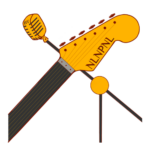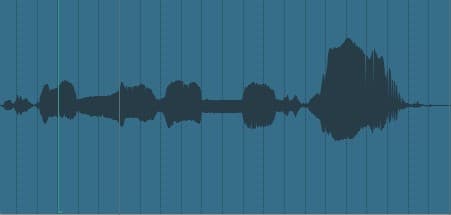
The last portion of this audio is biased to the upside
Asymmetrical waveforms: If you've been recording for any length of time, you've seen them. Many audio waveforms are roughly symmetrical. That is, they spend about equal time above and below the midline, and where there's an upswing, there's a downswing after it.
But sometimes, as in the image, you get a lopsided waveform. What causes it? Is it a problem? If so, how do we deal with it?
Asymmetrical Waveforms -- The Causes
It turns out there's more than one possible explanation for times when your waveform is biased to one side or another.
Some Sound Sources Produce Less Symmetrical Audio
Its worth pointing out that sound waves themselves are not perfectly symmetrical. Many are mostly symmetrical, but not perfectly. A sound wave is alternating zones of high and low air pressure (assuming we're talking about sound in air). The high and low peaks aren't precisely opposite.
But they're generally about the same.
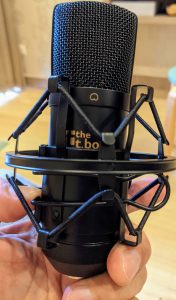
A microphone element vibrates back and forth in relation to these pressure waves. That back and forth motion creates positive and negative voltage, which is recorded and represented visually by a waveform.
But imagine how much energy is in a soundwave. If you hold a piece of paper up and sing into it, the sound vibrations barely move the paper. We're talking about subtle vibrations.
Plosives
But you know what will easily move a piece of paper? A puff of air. And a puff of air from a plosive 'p' will push the paper away from you, but not back very much. If that plosive were hitting a microphone element, it would result in a stronger force in one direction on the element. That would result a higher voltage to one way compared to the other -- an asymmetrical wave.
Lots Of Instruments Produce Asymmetrical Waveforms Via Phase Relationships
Trumpets, percussion, violins, voice, and even flute all can have asymmetrical waveforms. Even combined sine waves (perfectly symmetrical waveforms) of different frequencies can result in lopsided waveforms. It's physics, baby!
Tonal instruments are more harmonically complex than sine waves. Each instrument has a different tone. The tone differences are because of harmonic content. When you play an A - 440Hz on a piano, it produces other frequencies besides 440Hz. Most of those frequencies are multiples of 440Hz, called harmonics.
A clarinet sounds different tonally to a trumpet, largely because of the different proportions of harmonics in the sound.
With tonal instruments, it has to do with the fundamental frequency (the main note you hear playing) and the harmonics (other, related notes that ring) and how they add to and subtract from each other.
Odd numbered harmonics (the fundamental, 3rd harmonic, 5th harmonic, 7th harmonic and so on) are symmetrical when combined with the root note (fundamental frequency). Even numbered harmonics introduce asymmetry above or below the center line. So, an instrument with a higher proportion of even numbered harmonics, such as a trumpet, will likely be less symmetrical.
Atonal instruments (instruments that don't necessarily have a note you can pick out) also have multiple frequencies going on which can combine in various ways. These frequencies are not necessarily closely related to each other mathematically. But the result is the same -- sometimes they produce asymmetrical soundwaves and waveforms.
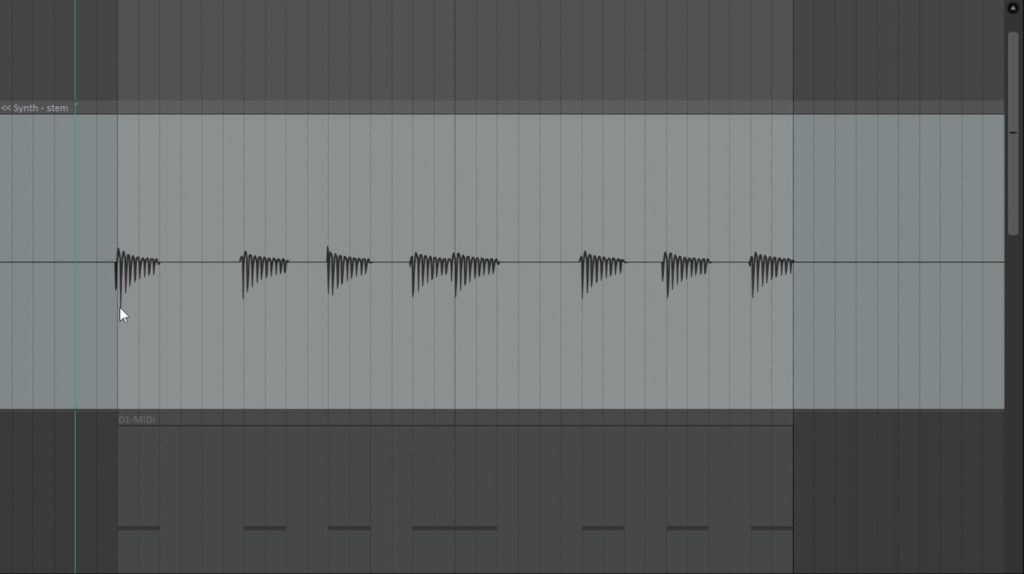
An asymmetrical waveform generated by a sawtooth wave with EQ
Bias To One Side Of The Waveform
Lots of instruments have a bias to one side or another because of how they're blown, played, or struck. When we sing, we breathe out. That means that the voice may create more air pressure in the direction away from the mouth. This will be most evident on sounds that include a rush of air, such as plosive sounds sometimes made by the sound 'p', and some sibilant sounds such as a percussive 'ch'.
Violins are bowed, up and down. Harmonicas are blown sometimes and air is sucked through them in the opposite direction others. Trumpets are played by blowing air through a narrow passage. This can create a pressure wave.
All of these situations can create lopsided waveforms. We'd want to fix plosives in a vocal track, but mostly, these kind of lopsided audio tracks are OK.
DC Offset
When a lot of people see asymmetrical waveforms, they think DC offset. But DC offset is rarely a problem these days. And as we've already seen, asymmetry can occur in multiple other ways. DC offset is generally caused by faulty equipment.
I'll tell you right now that DC offset is probably not your problem. I can't remember the last time I ran into it. Unless you see a waveform similar to the waveform in the image below, you can forget about it.
What if a soundcard introduces a stray DC voltage and it gets combined with the audio signal. Then your whole soundwave will move north or south of the zero line and you'll have asymmetry. In short, your audio signal will ride on (be superimposed on) that DC signal.
Diagnosing DC Offset
When the signal is quiet, does your waveform ride above or below the zero line? If so, that's probably DC offset.
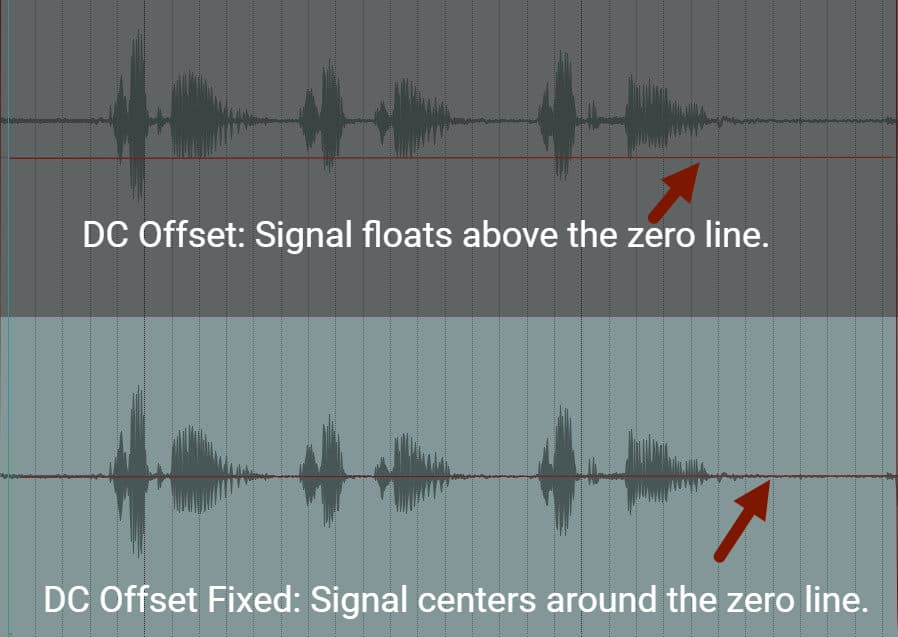
In the top half of the image, we see DC offset. In the bottom half, we've fixed it.
Fixing DC Offset
Most DAWs have a DC offset filter. if you see DC offset, use the tool :-). But don't worry. DC offset is rare in the wild.
Low End Processing
Using high-pass filters and some other kinds of processing on low frequencies can make the sound waves unbalanced. If you add more gain to these unbalanced waves, it makes the uneven energy distribution even more noticeable.
You can . . .
Potential Problems With Asymmetrical Waveforms
A lopsided signal usually isn't a problem. But here's why it might be and how you deal with it, if it is.
Headroom
Headroom is the difference between your signal level and the highest signal level a device can handle without problems. Lopsided signals can take up headroom.
In digital recording, it's generally considered bad if your signal goes above 0dBFS. So if you peak at -3dBFS, you have 3 dB of headroom.
But if you have a lopsided waveform, it reduces your headroom. Maybe one signal swings from -1dBFS on the upside and barely down below the 0 line on the downside. Even though it has the same range as a similar, symmetrical signal, you have less headroom.
Another example of headroom is a compressor. If you have a lopsided signal, it's going to trigger the compressor harder than a similar but more symmetrical swing.

Asymmetrical Waveform With No Headroom
Asymmetrical Waveforms: What To Do (If Anything)
Seriously. In 97% of cases, you won't need to do anything about a lopsided waveform. That's a statistic I totally made up, but it's pretty accurate. In cases in which you do need to do something, phase rotation, a high-pass filter (if your asymmetry is in low frequencies), or dialing back whatever processing is causing the problem are your answers.
And a DC offset filter for DC offset 🙂
Resources
Voxengo Span: Voxengo Span is a free, useful frequency analyzer which includes a peak meter. Windows & Mac.
Rea (Reaper) Plugins: ReaEQ, ReaComp, ReaXcomp, ReaDelay, ReaFIR and others come with Reaper or can be added. If you don’t have Reaper, you can download the VST versions of ReaEQ, and a few other useful plugins here.
REAPER JS Plugins: Specific to REAPER, the REAPER Stash is where you can find themes, plugins, effects, meters and more, written in the JS language. This includes JS Offset filter. The Reaper Blog has a great tutorial on how to install these REAPER-only plugins.
Enjoy
Keith
